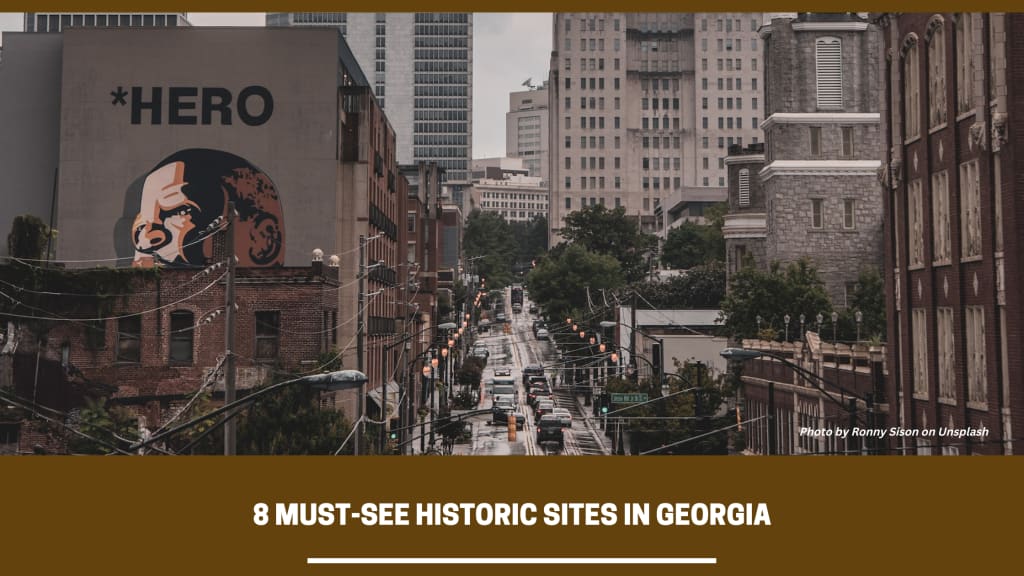8 MUST-SEE Historic Sites In Georgia
We'll give you our list of the top eight historic sites in Georgia that you should visit. We have incredible monuments, fascinating exhibits, historic museums, legendary battlegrounds, and much more.

Georgia state historic sites. There are eight incredible must-see attractions for you to visit.
We'll give you our list of the top eight historic sites in Georgia that you should visit. We have incredible monuments, fascinating exhibits, historic museums, legendary battlegrounds, and much more.
To be clear, this list includes national park sites (as opposed to national parks) rather than national parks.
1. Jarrell Plantation State Historic Site
The Jarrell Plantation State Historic Site in Juliette, Georgia, was owned by the Jarrell family for more than 140 years and is one of many historic plantations in Georgia.
The plantation was built in 1847 by John Fitz Jarrell, who later added many of the original furnishings seen today.
Nearly 40 enslaved African workers once worked on the cotton plantation, which was one of many middle-class cotton farms in the area.
They continued to work the land as free men after the Civil War, and Jarrell expanded his farm to over a thousand acres.
After John's death in 1884, his son, Dick Jarrell, returned home to run the farm. They were now primarily growing sugarcane, and he expanded the farm to include a sawmill, cotton gin, and other facilities.
A second home, barn, and other plantation remnants can still be seen today, as well as the Griswoldville Battlefield, a 17-acre site where the Battle of Griswoldville took place on November 22, 1864.
2. Jefferson Davis Memorial State Historic Site
The Jefferson Davis Memorial State Historic Site commemorates the location where Confederate President Jefferson Davis was arrested following the Civil War.
Union troops apprehended Davis and his family outside Irwin County, Georgia, one month after he fled Richmond, Virginia. They were camped in the woods, on their way west to reorganise the Confederate Army.
Davis was eventually returned to Virginia, where he was charged with treason and imprisoned for two years before being released.
Judge James Clements, whose father had purchased the land to keep it out of Yankee hands, donated it to the state of Georgia.
The Georgia historic site, located in the small town of Fitzgerald, features a large granite monument beneath a bronze bust of Jefferson Davis.
Visitors can also enjoy a Civil War Museum, gift shop, nature trail, playground, and group shelter.
3. Chief Vann House State Historic Site
The Cherokee Chief James Vann owned the Chief Vann House, one of the oldest structures in the North Georgia Mountains, in the 1790s.
Vann's house was passed down to his son, who also became a Cherokee leader, after he was murdered in 1809. When the Cherokee Nation was forced west in the 1830s, the family lost their home.
The house was both the Cherokee Nation's first brick home and its largest plantation. The 2.5-story home features hand carvings, a floating staircase, a 12-foot mantle, and period antiques.
Don't miss the Chief Vann House's beautiful seasonal gardens, which bloom with colour in the spring and fall.
Seasonal exhibits with varying themes are also available at the GA historic site, including historic maps of Georgia, handwoven baskets, and quilting.
Visitors should be aware that while the museum and grounds are ADA-compliant, the historic buildings are not.
4. Fort King George State Historic Site
The Fort King George State Historic Site in Darien, Georgia, is the only remaining English fort on the Georgia coast.
Built along the Darien River in 1721, the fort served as the British Empire's southern outpost from 1721 to 1726. At the time, Britain was fighting Spain and France for control of the southeastern United States.
Fort King George was largely staffed by The Independent Company of South Carolina due to its location.
During their difficult time at the fort, the company of 100 elderly foot soldiers faced starvation, alcoholism, desertion, mutiny, and various camp diseases.
General James Oglethorpe settled the fort after the British left, and had it dismantled in 1738. The state of Georgia later rebuilt it and designated it as a protected historic site.
Today, the Fort King George grounds include a moat, guardhouse, barracks, and other structures that are open for tours and educational programmes all year.
5. Fort Morris State Historic Site
Fort Morris State Historic Site, located about 40 minutes south of Savannah in Midway GA, occupies a strategic spot on the Medway River that was ideal for defending southern Georgia.
Throughout the 18th century, the fort was built, demolished, rebuilt, expanded, and abandoned several times.
It saw action in the French and Indian War, the American Revolution, the War of 1812, and the American Civil War.
The fort was used to keep British troops out of Georgia after the signing of the Declaration of Independence. They demanded the surrender of the 200 troops, but American Colonel John McIntosh told them to "come and take it!"
When the British returned 45 days later, they renamed the site Fort George and held it for 8 months. The British eventually left, and the site was not used again until the War of 1812.
The historic site now has a visitor's centre, nature trail, campgrounds, and a picnic area. Every year on Labor Day and Christmas, historic events are held there.
6. Hofwyl-Broadfield Plantation State Historic Site
One of the most popular historic sites near Savannah GA is the Hofwyl-Broadfield Plantation State Historic Site.
The historic site is located in Brunswick, about an hour south of Savannah, near Cumberland Island.
Over 350 enslaved Africans worked on the massive 7,000-acre rice plantation at its peak.
After its original owner, William Branford, died, the plantation was passed down through his family. By the end of the Civil War, the property had lost the majority of its value and had been converted into a dairy farm.
The property, which is now mostly marshland, is surrounded by sprawling, moss-covered oak trees. The park, which is popular with bird watchers, is surrounded by 4 miles of hiking trails.
A museum, visitor centre, and gift shop are available at the site.
7. Wormsloe State Historic Site
The Wormsloe State Historic Site in Savannah, Georgia, is home to some of the state's most beautiful oak trees.
The historic site is best known for its iconic entrance, which features a lovely avenue shaded by Spanish moss-covered oak branches.
The site also includes the ruins of Noble Jones' historic home. He was one of Georgia's first settlers, serving as a judge, surveyor, Royal Councilor, doctor, constable, and Indian agent.
The house was also one of many defensive structures built in Georgia to protect the coastline from Spanish invaders. It was made of tabby, a lime and oyster shell-based building material.
After Jones' death, the Wormsloe house was passed down to his grandson, George Jones. George constructed a larger plantation house, which is still standing here today.
The site includes the original home's ruins, a museum, a gift shop, an oak avenue, a walking trail, and a picnic area.
8. Robert Toombs House Historic Site
The home of former lawyer and Senator Robert Toombs is preserved at the Robert Toombs House Historic Site in Washington, Georgia.
Toombs was a staunch supporter of slavery, despite his volatile temper and dishevelled appearance. He frequently defended his position in the Senate, where he fought to keep his ideals alive prior to the Civil War.
Toombs also served as Secretary of State for Jefferson Davis before resigning in dissatisfaction with his failure to be elected President of the Confederacy.
Officials were concerned about his alcoholism and lack of diplomatic skills.
His outspoken opposition to many Confederate government decisions resulted in an arrest warrant. In 1865, he escaped his captors and fled to Paris.
He returned to continue his law practise two years later, but he was never able to run for public office again.
Today, the Toombs House Historic Site includes a museum that provides visitors with customised tours and educational programmes.
About the Creator
Amit Kumar
Full-time thinker & part-time writer...






Comments
There are no comments for this story
Be the first to respond and start the conversation.